|
The idea of my Macondo derives from 2000 when I got delivery of Avantgarde Trio.
It was my first multiwave horn-loaded acoustic system (before I used Avantgarde
Duo) and I was very encouraged with some opportunities which multiwaved horns offered.
I was discovering also that Avantgarde Trio had multiple design problems that led
to multiple areas of sonic impotency. With time I nailed down them and worked on
dealing with the Trio’s limitations. I need to admit that I am very much not DIY-minded
person, neither audio-scientific type of person and, although I practiced audio
for many years, I had absolutely no theoretical or knowledge about loudspeakers.
Saying it, I have to tell that I built my first acoustic system when I was 10 years
old; however at that time I had truly no understanding of what I was doing. So,
it took me 2 years experimenting with Avantgarde Trio: replacing, drivers, horns,
frames, filters, the ways how everything was used and educating myself with very
rudimental principals of acoustic systems. I ended up with something that reminded
“Trio” only because it used Avantgarde’s upper bass horn but it sounded very far
from what Trio could offer.
It was fully custom-arranged 109dB sensitive 4-way installation driven by multi-amped
SETs. Then, along with evolution of my sonic demands I understood that what I was
able to get out of my current at that time acoustic system did not work out for
me. At that time my playback did very high quality Sound in Audio terms. It was
musical also but I had no control over the depth and specifics of that musicality.
I understood the need to use different principals for acoustic system’s
considerations and construction if I want to get more out of my playback then just
"good sound". The period of 200-2002 was the most interesting in development of
my understanding of audio. Absorbing some ideas from multiple sources (not always
from audio domain) and bi-amping my custom “Trio” speakers with the most advanced
and intellectually-loaded commercial amplifier known to me today (Lamm ML2.0) I
was discovering that audio is capable to carry out own creative expressionism and
has own language, idiomizing musicality via own audio phonetics and own audio syntax.
At that time, right along with my deepening understanding of music itself, I began
to open audio as an interpretive representation of musicality that embodies and
symbolizes my expressive intentions.
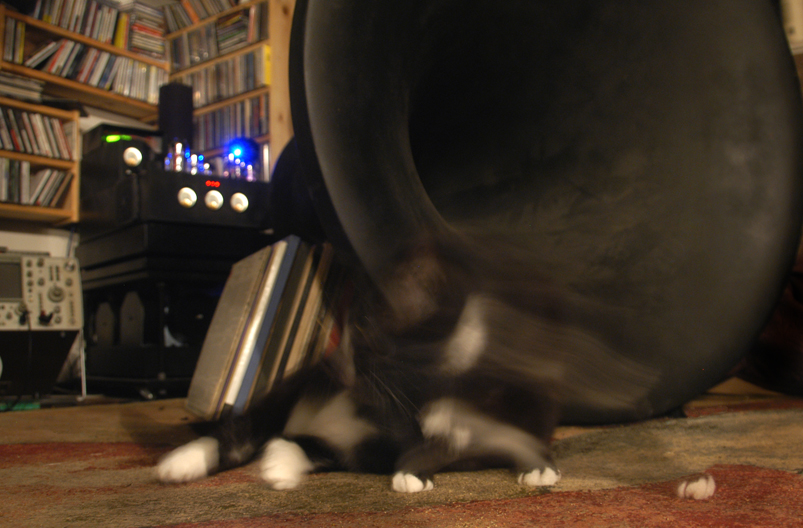
Karajan told that he conducts two orchestras: one in front of him and one in his
dreams – the imaginary orchestra, it was exactly how I felt about audio
and I perceived acoustic system as a decisive tool of audio language. I was looking
for means to deal with sonic expressivity via the means of audio. I looked into
books and talked with “knowledgeable” people but I witnessed that their knowledge
did little to what I was looking and that they demonstrated a complete lack of understanding
in what I was interested. I was trying to found out why some acoustic systems, while
they are playing similar capable/loaded material, have resulting differences. Why
some of speakers do not express the necessary depth of sorrow, why some speakers
unproportionally expand jubilations, why some speakers more or less forgiving and
more or less critical to musicians making technical mistakes or interpretive inaccuracies,
why some speakers demonstrate different level of tonal nobility and where tone comes
in loudspeakers altogether, why some speakers has means to highlight or to restrain
certain tempos, why one acoustic systems playing a foreign singer makes me to fell
gratitude and respect for the singer’s linguistic attempts and another acoustic
systems make me to feel annoyed by the singer’s accent, why some acoustic systems
make music shallow and light and another acoustic systems make music more meaningful
and significant then it should be, why some speakers renders the pitches right but
have no consequential connection between the notes, why some speakers make music
like musicians lost their senses of what they were doing, why some loudspeakers
throw overly graphic imaging and disassociate imaging from listening attention,
why some speakers have more momentous impacts and some long-lasting impact, why
some acoustic systems make listener more concentrate on details and why some speakers
makes perception to grasp music as “a whole”, why some loudspeakers create listening
sympathy between listener and musician and some disassociate the performer from
listener’s sympathy, why some acoustic systems act overlay hypercritical over the
performing interpretation and some are not judgmental enough, why some acoustic
systems have a specific preferences in their judgmentalism… There were hundreds
of other “whys” but there were no answers and there was no “knowledge door” to which
I might knock…
It looked to me like the entire audio knowledge was concentrated on the subjects
that had absolutely no relation to what I understood audio was all about. So, I
decided to invent my own “audio knowledge” and my slogan was “You do not need to
know in order to know”. Toward to this end my views from other areas of my professional
and artistic experiences came together. I never try to develop critical mass of
knowledge in anything but I rather look for patterns that lead to knowledge in case
any answers are necessary. So, I begun to learn how a payback might be objectively
evaluated using the only valid instrument that is important and that I had a control
over – my listening consciousness. To my huge surprise as soon I begin to look into
this direction then the right answers begin to pop up like mushrooms after rain.
I suddenly realized that I am getting a grip upon an extremely powerful tool that
allowed me to view everything known about loudspeaker from a different angle
– the angle where there is no conflict between objective and subjective, between
auditable and measurable, between momentary perceived and factual. It was not instantaneous
revelation but rather an evolutionary process, the process that last from 2002 to
2004, and continuing nowadays.
So, Macondo Acoustic System was re-thought and re-build over the course of a few
years, using primary my “alternative” principles of audio assessments, where audio
decisions were made on the merits of listening experience’s adequacy. Whatever audio
decisions I made with Macondo were pretty much reinvented by me, no matter that
they exists and perhaps widely used everywhere – I did not chased the decisions
but rather was looking my own reasons to make the decisions. I have a strong
disestablishment attitude and I did not let the habitual zombianic practice of loudspeaker
construction to influence my Macondo project.
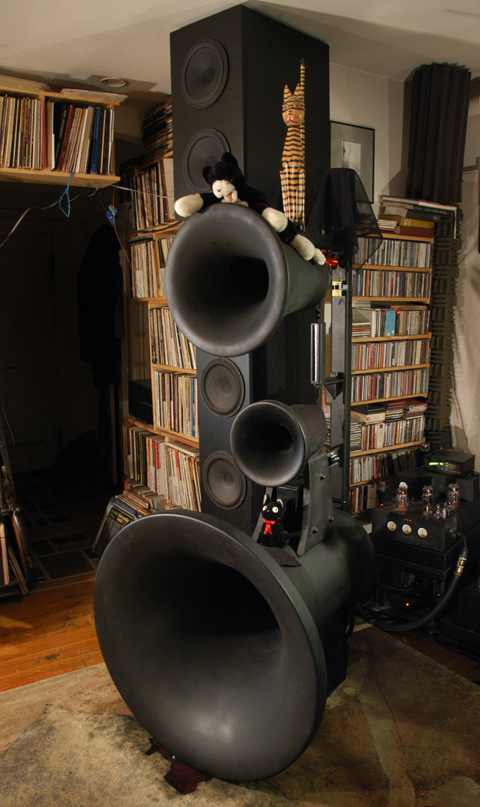
Macondo Acoustic System without Injection Chanel.
After 2003 I begun to feel that I need more then what Lamm ML2.0 was potent to offer
and in 2 years Melquiades was born. In another 2 year the Melquiades DSET became
an organic ingredient of Macondo. So, what Macondo is now?
Macondo Acoustic System is 6 ways, in my case fully-active, room-specific loudspeaker
implementation that was built to serve a highest possible INTERPRETIVE PURPOSE with
a presumption that the played musical material is ”loaded” and possess worthy musical
values. The System has 6 channels: Bass, Upper Bass, Fundamentals, Mid Range, Higher
Frequency and Injection Channel. Each channel has own duty viewed and assessed in
context of other channels. The drivers are properly integrated using my own assessment
methods. Each right and left channels is above 8’ tall, above 4.5’ wide and weights
about 800 pounds. All Macondo's channels are uniquely integrated and voiced according
to their TTH performance, each driver individually (and not identically) loaded
to own amplification to assure proper acoustic-like harmonic saturation across the
whole frequency range. The entire system is capable to throw a very stable and very
“interesting” imaging from incredible distance of … 6.5 feet. No analog time-correction,
no DSP methods, no EQ-ing, no Zobel-ing, no notching, were used anywhere within
Macondo. The current adaptation of Macondo also does not use any speaker-level filters
and all channels are-direct coupled to own narrow-frequency amplifiers. Each thoroughly
and objectionably selected driver operates naturally within own most-optimum frequency
range and own most-optimum electric and loading environment. The System meticulously
time-aligned by natural means and is appropriately Macro-Imbedded into listening
room.

Macondo Acoustic System with Injection Chanel.
For Higher Frequency Channel Macondo uses "Water Drop" tweeter - a custom made by
RAAL driver. It is 109dB sensitive, 120 degrees horizontal dissipating, with narrow
vertical dissipation to shoot precisely between the horns, true-ribbon driver, which
was optimized explicitly for HF operation. The ribbon is driven by anode voltage
of 2W single-stage 6E6P Melquiades DSET via a 175:1, foil-to-wire output transformer
with amorphous core.
For Mid Range Channel Macondo uses 109dB sensitive Vitavox S2 driver, operating
between 1kHz and 12.5kHz and loaded into custom built by John Hasquin’s tractrix
400Hz horn. The MF channel is direct-coupled to a single-stage dedicated Melquiades
DSET featuring 6E6P with a capacitor-less crossover at 3.2kHz. The channel uses
an amorphous custom Tribute transformer with limited turns/inductance and LF response
down to 400Hz.
The Macondo’s 93dB sensitive Injection Channel uses Tannoy 10” RED driver in a sealed
enclosure, driven by full-power Melquiades SET with full-range amorphous Lundahl
transformer. The channel is high-passed at 110Hz and runs at minus 14dB.
The Macondo's 109dB sensitive Fundamentals Channel consists of Vitavox S2 driver
operating at its lover range (600-1000Hz) and loaded into Bruce Elgar-made 250Hz
Tractrix Horn. The Fundamentals Channel is direct-coupled to a single-stage 6E5P,
2.6W DSET amp with amorphous Lundahl transformer and has a speaker level L-Pad for
defined dialing-in the channel’s output.
The Macondo's Upperbass Channel is 109dB sensitive and coverers (Macro-Imbedded)
from 95Hz to approximately 650Hz. The channel employs Fane Studio 8M driver used
as a compression driver, loaded into 4” throat. The horn was custom-built by John Hasqiun.
The channel is driven by a dedicated line-level band-passed (60Hz -500Hz) Melquiades
DSET with amorphous Lundahl transformer
The Macondo’s Bass Channel is line arrays. The arrays employ religiously-sealed
enclosures with six “spotted” Scan Speak 25W/8565-00 drivers per channel. The 97.5dB
sensitive arrays are direct-coupled full power Melquiades DSET with a high inductance,
not multi-sectioning; not de-magnetizing, 450mA gaped, rolling at 800Hz, large core-mass
transformer that begins to clip at 7.5Hz at full power.
Sonically Macondo Acoustic System has many virtues that I do not recognize in other
acoustic systems - I am saying not to satisfy my ego but rather to state a fact.
Macondo combines very precise amount of the tonal firework (that a few chosen loudspeakers
from 50s had) with a high linearity and precision of contemporary loudspeakers.
However, in context of Macondo the word “precision” has a different meaning.
Macondo has integrity to do what is necessary to audio-embellish sonic presentation
but (to the best of my today’s understanding) Macondo knows where to stop and this
speaker do not go overboard in any perceived tangential characteristic of sound
reproduction. Macondo is very discriminating and judicious Acoustic System – it
has an ability to distinguish differences and nuances (would it be tonal or dynamic)
in played music but at the same time it has a necessary amount of provocativness
to teas listening awareness with strategically-thrown sonic encouragements and dynamic
dictations. However, despite of the Macondo’s ability to highlight the necessary
(in my view) highlightable moments in music I have no taste for sonic grotesque
and the Macondo’s accents are made with a great respect to a proper balance between
the unavoidable playback artifacts and the musical benefit. What stays behind of
it is that Macondo does not follow any dead-beat definition of audio neutrality.
Macondo has own definition of neutrality and cares not about the neutrality
and fidelity of the renderable sounds but rather about the impartiality, conformity
and adequacy of listening experiences. Macondo “voiced” according to completely
different methods and different criteria – it made to be as neutral as possible
in Dynamic, Emotional, Esthetic, Ethical and Re-Creative interpretation of musicality.
Does Macondo sound “neutral” from Hi-Fi perspective? Does it do the all-mandatory
audiophile-proven tricks? It’s hard to answer as I have a lot of attitude about
this subject and I see the mandatory audiophile-proven tricks from a different perspective:
for me the audio-tricks are not the results but rather instruments for accomplishing
other goals. Anyhow, I presume that Macondo does hit the necessary Hi-Fi checkpoints,
at least the people who heard Macondo lately told me that it does.
What is also important to mention is that Macondo Acoustic System is not a design
that I advocate as a “winning design” (though I do have a lot of convictions about
it). The Macondo concept is not the collection of drivers, horns and frames; it
is not the specific implementation – you will not be able to see what Macondo System
is all about until you understand the correlation between what it meant to do and
what it does. The Macondo System is rather a concept, a winning sequence of conscious
ceremonial realizations and actions that lead a person from taking a room
and converting it into a sensible and involved medium of musical intercourse.
Macondo Acoustic System will grow (or decline) right along with the changes of my
demands for sound reproduction complexity. There are some areas that I might explore
with Macondo. The time will show…
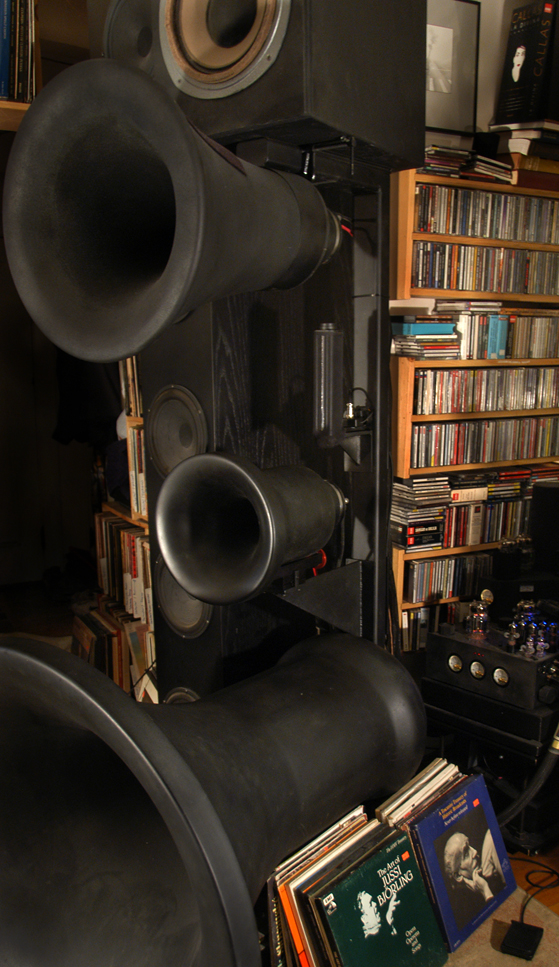
The latest version of Macondo Acoustic System
If you are interested about Macondo Acoustic System then here is the list or recommended
reading on my site, I would also encourage you to familiarize yourself with the
linked threads to the listed topics :
PS: Update at 2010. More details is comming:
http://www.goodsoundclub.com/Site_Images/NewRoom_NoWindows.JPG
http://www.goodsoundclub.com/Site_Images/NewRoom_AcousticTreatment_15.JPG
http://www.goodsoundclub.com/Site_Images/NewRoom_GlassBack.JPG
http://www.GoodSoundClub.com/TreeItem.aspx?PostID=14483
The 2010 addition to Macondo – a dedicated, DSET driven, 42Hz hyperbolic, midbass horn,
installed to be “invisible” in the room and in time-aligned configuration.
The channel use Vitavox 15/40 driver.
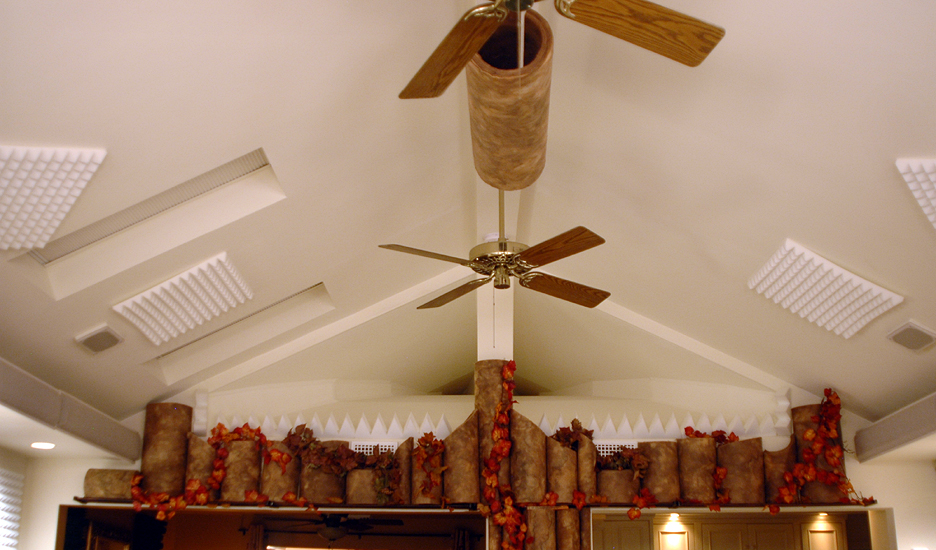
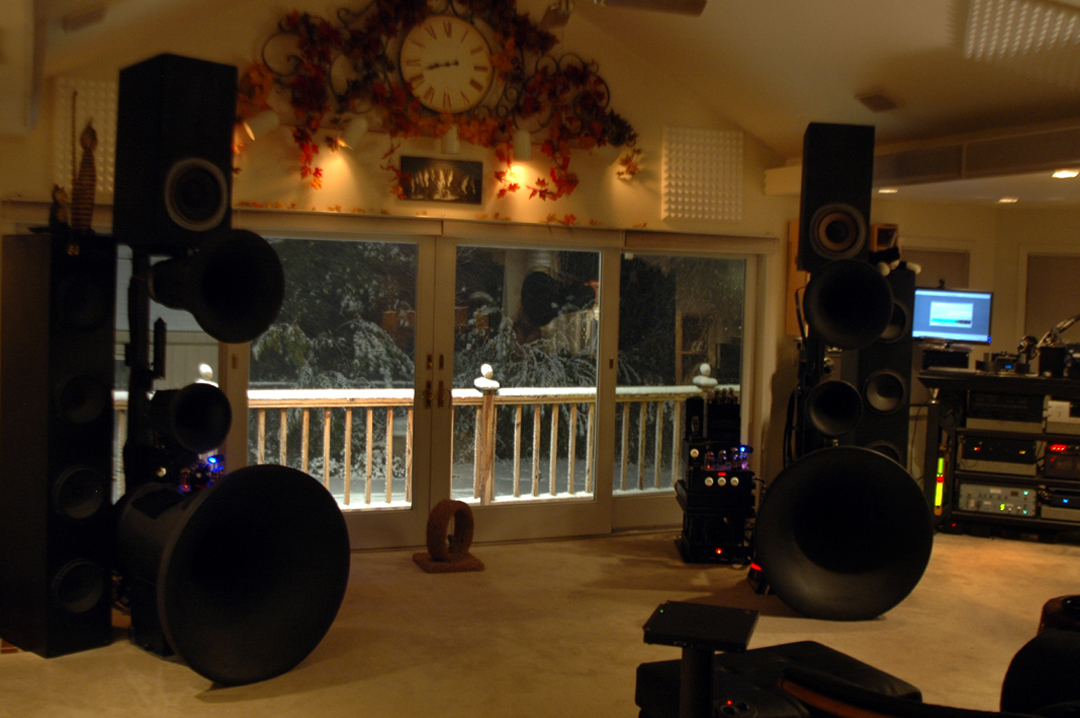
In 2016, after 5 years of marriage, 3 new kids we moved to a new home, or as the “straight people” call it a “new school district”.
Everything changed, including a priority to a degree, but the Macondo is still there, in a new semi-dedicated listening room, very much true to the original design.

More reading:
|